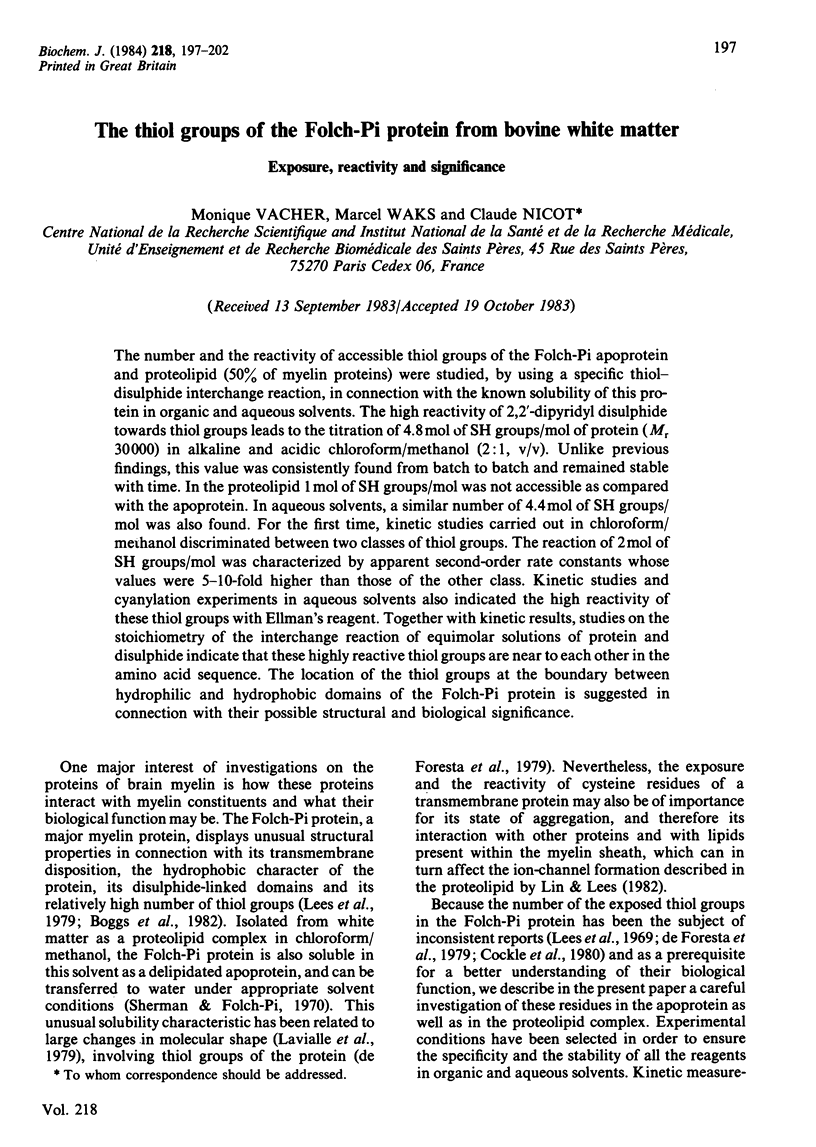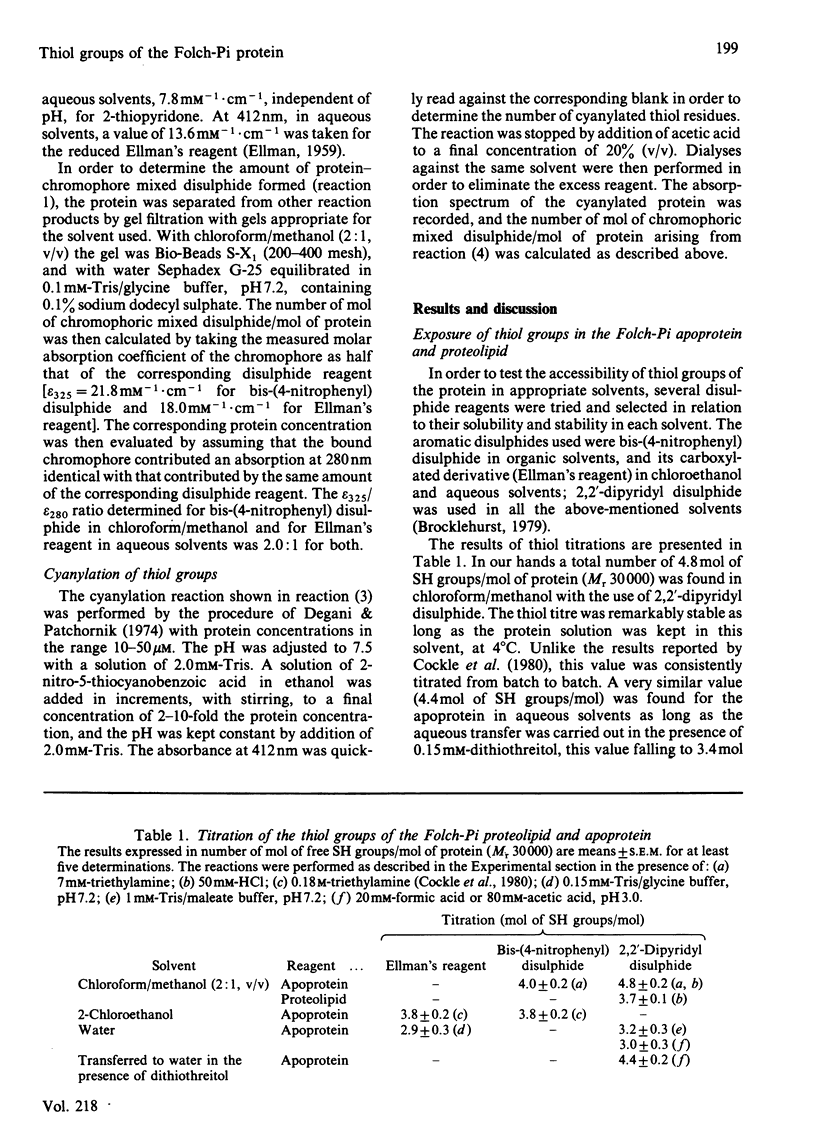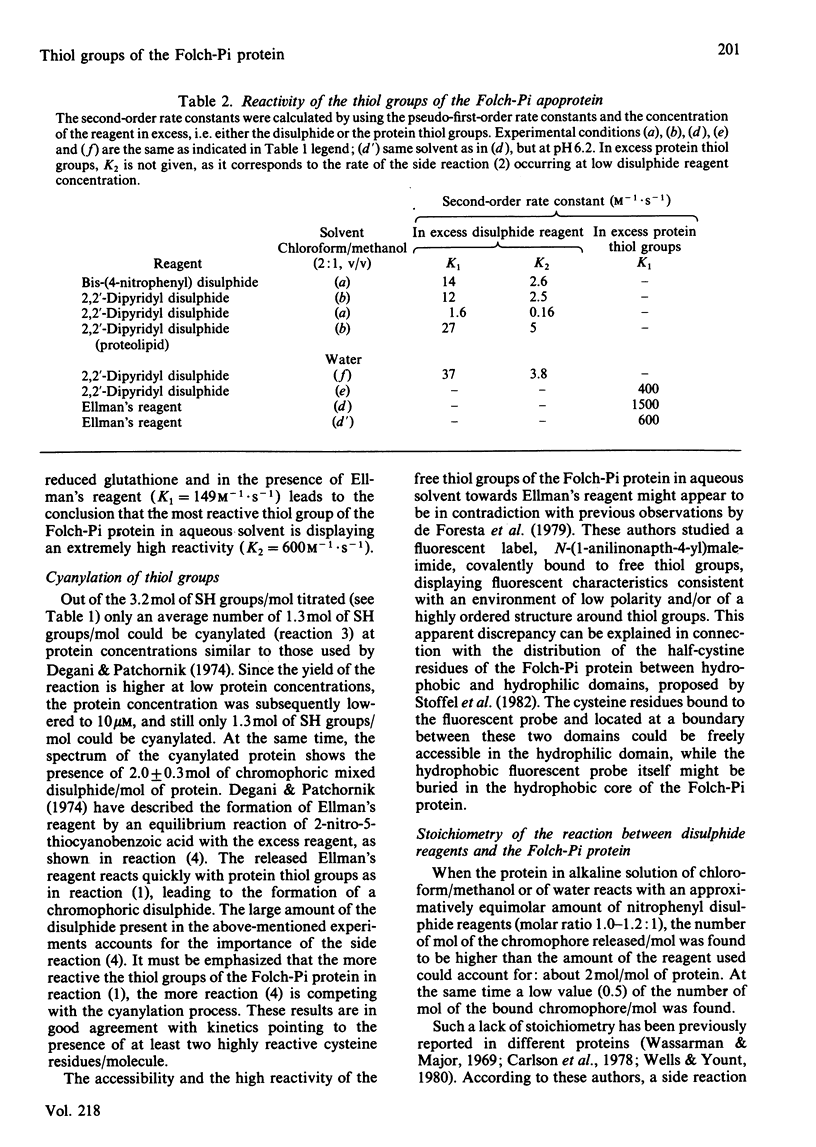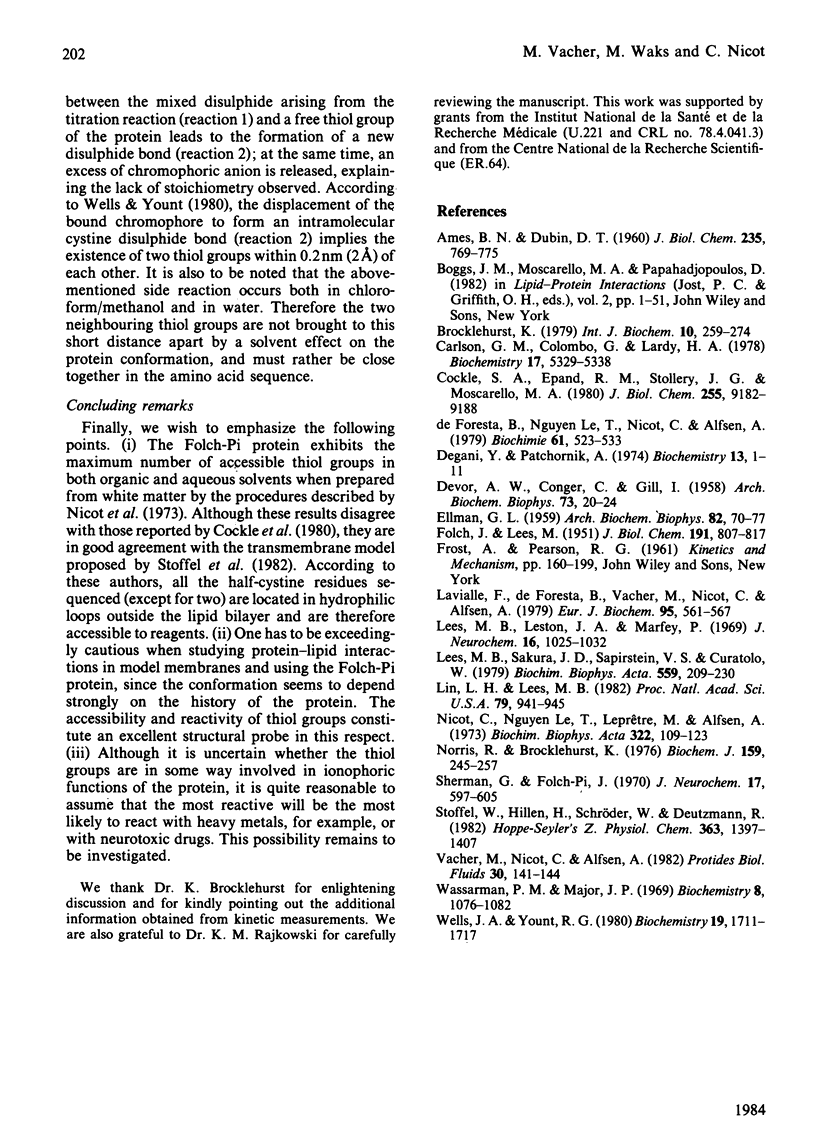Abstract
The number and the reactivity of accessible thiol groups of the Folch-Pi apoprotein and proteolipid (50% of myelin proteins) were studied, by using a specific thiol-disulphide interchange reaction, in connection with the known solubility of this protein in organic and aqueous solvents. The high reactivity of 2,2'-dipyridyl disulphide towards thiol groups leads to the titration of 4.8 mol of SH groups/mol of protein (Mr 30000) in alkaline and acidic chloroform/methanol (2:1, v/v). Unlike previous findings, this value was consistently found from batch to batch and remained stable with time. In the proteolipid 1 mol of SH groups/mol was not accessible as compared with the apoprotein. In aqueous solvents, a similar number of 4.4 mol of SH groups/mol was also found. For the first time, kinetic studies carried out in chloroform/methanol discriminated between two classes of thiol groups. The reaction of 2 mol of SH groups/mol was characterized by apparent second-order rate constants whose values were 5-10-fold higher than those of the other class. Kinetic studies and cyanylation experiments in aqueous solvents also indicated the high reactivity of these thiol groups with Ellman's reagent. Together with kinetic results, studies on the stoichiometry of the interchange reaction of equimolar solutions of protein and disulphide indicate that these highly reactive thiol groups are near to each other in the amino acid sequence. The location of the thiol groups at the boundary between hydrophilic and hydrophobic domains of the Folch-Pi protein is suggested in connection with their possible structural and biological significance.
Full text
PDF





Selected References
These references are in PubMed. This may not be the complete list of references from this article.
- AMES B. N., DUBIN D. T. The role of polyamines in the neutralization of bacteriophage deoxyribonucleic acid. J Biol Chem. 1960 Mar;235:769–775. [PubMed] [Google Scholar]
- Brocklehurst K. Specific covalent modification of thiols: applications in the study of enzymes and other biomolecules. Int J Biochem. 1979;10(4):259–274. doi: 10.1016/0020-711x(79)90088-0. [DOI] [PubMed] [Google Scholar]
- Carlson G. M., Colombo G., Lardy H. A. A vicinal dithiol containing an essential cysteine in phosphoenolpyruvate carboxykinase (guanosine triphosphate) from cytosol of rat liver. Biochemistry. 1978 Dec 12;17(25):5329–5338. doi: 10.1021/bi00618a002. [DOI] [PubMed] [Google Scholar]
- Cockle S. A., Epand R. M., Stollery J. G., Moscarello M. A. Nature of the cysteinyl residues in lipophilin from human myelin. J Biol Chem. 1980 Oct 10;255(19):9182–9188. [PubMed] [Google Scholar]
- DEVOR A. W., CONGER C., GILL I. The use of resorcinol for identification and determination of monosaccharide groups; a report on a Gaucher spleen cerebroside. Arch Biochem Biophys. 1958 Jan;73(1):20–28. doi: 10.1016/0003-9861(58)90236-4. [DOI] [PubMed] [Google Scholar]
- De Foresta B., Nguyen Le T., Nicot C., Alfsen A. Study of fluorescent tryptophyl residues and extrinsic probes for the characterization of molecular domains of Folch-Pi apoprotein. Biochimie. 1979;61(4):523–533. doi: 10.1016/s0300-9084(79)80208-4. [DOI] [PubMed] [Google Scholar]
- Degani Y., Patchornik A. Cyanylation of sulfhydryl groups by 2-nitro-5-thiocyanobenzoic acid. High-yield modification and cleavage of peptides at cysteine residues. Biochemistry. 1974 Jan 1;13(1):1–11. doi: 10.1021/bi00698a001. [DOI] [PubMed] [Google Scholar]
- ELLMAN G. L. Tissue sulfhydryl groups. Arch Biochem Biophys. 1959 May;82(1):70–77. doi: 10.1016/0003-9861(59)90090-6. [DOI] [PubMed] [Google Scholar]
- FOLCH J., LEES M. Proteolipides, a new type of tissue lipoproteins; their isolation from brain. J Biol Chem. 1951 Aug;191(2):807–817. [PubMed] [Google Scholar]
- Lavialle F., de Foresta B., Vacher M., Nicot C., Alfsen A. The molecular size and shape of the Folch-Pi apoprotein in aqueous and organic solvents. Eur J Biochem. 1979 Apr;95(3):561–567. doi: 10.1111/j.1432-1033.1979.tb12997.x. [DOI] [PubMed] [Google Scholar]
- Lees M. B., Leston J. A., Marfey P. Carboxymethylation of sulphydryl groups in proteolipids. J Neurochem. 1969 Jun;16(3):1025–1032. doi: 10.1111/j.1471-4159.1969.tb08993.x. [DOI] [PubMed] [Google Scholar]
- Lees M. B., Sakura J. D., Sapirstein V. S., Curatolo W. Structure and function of proteolipids in myelin and non-myelin membranes. Biochim Biophys Acta. 1979 Aug 20;559(2-3):209–230. doi: 10.1016/0304-4157(79)90002-9. [DOI] [PubMed] [Google Scholar]
- Lin L. F., Lees M. B. Interactions of dicyclohexylcarbodiimide with myelin proteolipid. Proc Natl Acad Sci U S A. 1982 Feb;79(3):941–945. doi: 10.1073/pnas.79.3.941. [DOI] [PMC free article] [PubMed] [Google Scholar]
- Nicot C., Le T. N., Leprêtre M., Alfsen A. Study of Folch-Pi apoprotein. I. Isolation of two components, aggregation during delipidation. Biochim Biophys Acta. 1973 Sep 21;322(1):109–123. doi: 10.1016/0005-2795(73)90181-5. [DOI] [PubMed] [Google Scholar]
- Norris R., Brocklehurst K. A convenient method of preparation of high-activity urease from Canavalia ensiformis by covalent chromatography and an investigation of its thiol groups with 2,2'-dipyridyl disulphide as a thiol titrant and reactivity probe. Biochem J. 1976 Nov;159(2):245–257. doi: 10.1042/bj1590245. [DOI] [PMC free article] [PubMed] [Google Scholar]
- Sherman G., Folch-Pi J. Rotatory dispersion and circular dichroism of brain "proteolipid" protein. J Neurochem. 1970 May;17(5):597–605. doi: 10.1111/j.1471-4159.1970.tb00539.x. [DOI] [PubMed] [Google Scholar]
- Stoffel W., Hillen H., Schröder W., Deutzmann R. Lipophilin (proteolipid apoprotein) of brain white matter. Purification and amino acid sequence studies of the four tryptophan fragments. Hoppe Seylers Z Physiol Chem. 1982 Nov;363(11):1397–1407. doi: 10.1515/bchm2.1982.363.2.1397. [DOI] [PubMed] [Google Scholar]
- Wassarman P. M., Major J. P. The reactivity of the sulfhydryl groups of lobster muscle glyceraldehyde 3-phosphate dehydrogenase. Biochemistry. 1969 Mar;8(3):1076–1082. doi: 10.1021/bi00831a039. [DOI] [PubMed] [Google Scholar]
- Wells J. A., Yount R. G. Reaction of 5,5'-dithiobis(2-nitrobenzoic acid) with myosin subfragment one: evidence for formation of a single protein disulfide with trapping of metal nucleotide at the active site. Biochemistry. 1980 Apr 15;19(8):1711–1717. doi: 10.1021/bi00549a030. [DOI] [PubMed] [Google Scholar]


